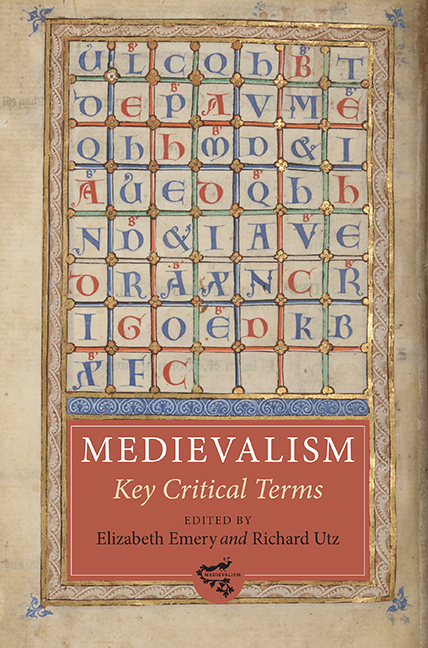Book contents
- Frontmatter
- Dedication
- Contents
- List of Illustrations
- List of Contributors
- Making Medievalism: A Critical Overview
- 1 Archive
- 2 Authenticity
- 3 Authority
- 4 Christianity
- 5 Co-disciplinarity
- 6 Continuity
- 7 Feast
- 8 Genealogy
- 9 Gesture
- 10 Gothic
- 11 Heresy
- 12 Humor
- 13 Lingua
- 14 Love
- 15 Memory
- 16 Middle
- 17 Modernity
- 18 Monument
- 19 Myth
- 20 Play
- 21 Presentism
- 22 Primitive
- 23 Purity
- 24 Reenactment
- 25 Resonance
- 26 Simulacrum
- 27 Spectacle
- 28 Transfer
- 29 Trauma
- 30 Troubadour
- Index
- Medievalism
Making Medievalism: A Critical Overview
Published online by Cambridge University Press: 08 October 2022
- Frontmatter
- Dedication
- Contents
- List of Illustrations
- List of Contributors
- Making Medievalism: A Critical Overview
- 1 Archive
- 2 Authenticity
- 3 Authority
- 4 Christianity
- 5 Co-disciplinarity
- 6 Continuity
- 7 Feast
- 8 Genealogy
- 9 Gesture
- 10 Gothic
- 11 Heresy
- 12 Humor
- 13 Lingua
- 14 Love
- 15 Memory
- 16 Middle
- 17 Modernity
- 18 Monument
- 19 Myth
- 20 Play
- 21 Presentism
- 22 Primitive
- 23 Purity
- 24 Reenactment
- 25 Resonance
- 26 Simulacrum
- 27 Spectacle
- 28 Transfer
- 29 Trauma
- 30 Troubadour
- Index
- Medievalism
Summary
THE FIELD OF medievalism studies owes a tremendous debt to Leslie J. Workman and Kathleen Verduin. They worked indefatigably throughout the 1980s and 1990s to foster critical academic interest in “medievalism,” previously understood rather vaguely as a term describing a largely amateur nineteenth-century interest in what had since become the venerable twentieth-century discipline of “medieval studies.” By 1979, Workman had published the first issue of Studies in Medievalism, the journal which would develop into a widely recognized peer-reviewed publication through an ongoing association with Boydell & Brewer. In 1981, he began collaborating with his wife, Kathleen Verduin, a professor of American Literature at Hope College in Michigan. By 1986, they had begun a conference series, now known as the International Conference on Medievalism, and a proceedings series, The Year's Work in Medievalism. Together, they created a nexus of medievalism studies in the English-speaking academy.
We begin this introduction to Medievalism: Key Critical Terms with a tribute to Leslie Workman and Kathleen Verduin's achievements because the struggles they faced in bringing academic recognition to medievalism studies – tensions among “professionals” and “amateurs,” Western Europeans and “Others”; debates about “pastism” and “presentism,” memory and subjectivity; deconstructions of the concepts of authenticity, authority, and the academic disciplines and institutions reliant on them – reflect the development of the field as a whole. The idea of a dictionary or encyclopedia of critical terms in medievalism is also Leslie Workman’s: a project left unfulfilled at the time of his death (2001). While the present volume does not seek to emulate the exhaustivity of such an encyclopedia, it does owe its existence to Workman's wish to engage with the contested terms used when speaking of medievalism. This introductory essay will provide a brief definition of “medievalism,” as well as an overview of the development of medievalism studies, now so recognized that it warrants a book like this one.
Medievalism: An Overview
Workman provided and spread the foundational notion of medievalism as the ongoing process of recreating, reinventing, and reenacting medieval culture in postmedieval times.
- Type
- Chapter
- Information
- Medievalism: Key Critical Terms , pp. 1 - 10Publisher: Boydell & BrewerPrint publication year: 2014

